
4
5
7
6
3
1
2
Wireless Stereo
Headphone System
Operating Instructions
4-725-918-12(1)
MDR-RF912RK
©2017 Sony Corporation Printed in China
How to use
Charge the headphones.
Insert the supplied rechargeable battery into the left housing of
the headphones.
Observe the correct polarity when installing battery.
Connect the A/V component, following hookup or below.
Using the headphone jack of the A/V component
Headphone
jack (Stereo
mini jack)
TV, Digital music player, etc.
Turn on the A/V component.Wear the headphones.
Before listening
To reduce the risk of hearing damage, first
lower the volume.
Tactile dot
Checking the included items
AC adaptor (1)
RF stereo transmitter
TMR-RF912R
Wireless stereo headphones
MDR-RF912R
Rechargeable nickel-metal
hydride battery BP-HP550-11 (1)
Plug adaptor (stereo mini
plug phono plugs) (1)
Adjust the volume.
Tactile dot
If you cannot receive a clear audio signal
First change the radio frequency with the CHANNEL selector switch
on the transmitter, then change the radio frequency to that of the
transmitter with the channel switch on the headphones.
English Wireless Stereo Headphone System
WARNING
To reduce the risk of fire or electric shock, do not
expose this apparatus to rain or moisture.
To reduce the risk of fire or electric shock, do not expose
this apparatus to dripping or splashing, and do not place
objects filled with liquids, such as vases, on the apparatus.
Do not expose the batteries (battery pack or batteries
installed) to excessive heat such as sunshine, fire or the
like for a long time.
To avoid electrical shock, do not open the cabinet. Refer
servicing to qualified personnel only.
Do not install the appliance in a confined space, such as a
bookcase or built-in cabinet.
The AC Adaptor is not disconnected from the mains as
long as it is connected to the AC outlet, even if the unit
itself has been turned off.
As the main plug of AC power adaptor is used to
disconnect the AC power adaptor from the mains, connect
it to an easily accessible AC outlet. Should you notice an
abnormality in it, disconnect it from the AC outlet
immediately.
Excessive sound pressure from earphones and
headphones can cause hearing loss.
The nameplate of transmitter is located on the bottom
exterior.
Information
You are cautioned that any changes or modifications not
expressly approved in this manual could void your
authority to operate this equipment.
If you have any questions about this product, you may
call:
Sony Customer Information Services Center
1-800-222-7669 or http://www.sony.com/
Declaration of Conformity
Trade Name: SONY
Model No.: MDR-RF912R
(Headphones Unit)
Responsible Party: Sony Electronics Inc.
Address: 16535 Via Esprillo, San Diego, CA
92127 USA
Telephone No.: 858-942-2230
This device complies with Part 15 of the FCC Rules.
Operation is subject to the following two conditions: (1)
this device may not cause harmful interference, and (2)
this device must accept any interference received,
including interference that may cause undesired
operation.
Note
This equipment has been tested and found to comply with
the limits for a Class B digital device, pursuant to Part 15 of
the FCC Rules. These limits are designed to provide
reasonable protection against harmful interference in a
residential installation. This equipment generates, uses
and can radiate radio frequency energy and, if not
installed and used in accordance with the instructions,
may cause harmful interference to radio communications.
However, there is no guarantee that interference will not
occur in a particular installation. If this equipment does
cause harmful interference to radio or television reception,
which can be determined by turning the equipment off
and on, the user is encouraged to try to correct the
interference by one or more of the following measures:
– Reorient or relocate the receiving antenna.
– Increase the separation between the equipment and
receiver.
– Connect the equipment into an outlet on a circuit
different from that to which the receiver is connected.
– Consult the dealer or an experienced radio/ TV
technician for help.
For the customers in Canada
This device complies with Industry Canada’s licence-
exempt RSSs. Operation is subject to the following two
conditions:
(1)This device may not cause interference; and
(2)This device must accept any interference, including
interference that may cause undesired operation of the
device.
For the customers in the USA and
Canada
RECYCLING NICKEL METAL
HYDRIDE BATTERIES
Nickel Metal Hydride batteries are
recyclable. You can help preserve our
environment by returning your used
rechargeable batteries to the collection
and recycling location nearest you.
For more information regarding recycling of
rechargeable batteries, call toll free 1-800-822-8837, or
visit http://www.call2recycle.org
Caution:
Do not handle damaged or leaking Nickel Metal
Hydride batteries.
(Red) (Off)
Complete when indicator
turns off.
After use
Take off the headphones, then turn off the power.
About sending RF signals
The transmitter starts sending RF signals automatically
when it detects an audio signal from the connected
component.
Notes
If hiss is heard, move closer to the transmitter.
You may hear some noise when you disconnect the
AC adaptor from the transmitter before turn off the
headphones.
If no signal or low signal is input
for about 4 minutes
If the transmitter does not detect an audio signal for
about 4 minutes, it will stop sending RF signals
automatically*, and the POWER indicator will blink for
1 minute, then turn off. The transmitter restarts after
receiving an audio signal again.
The transmitter may also turn off if low signal is input
for about 4 minutes. In this case, raise the volume of
the connected A/V component within the range where
the sound is not distorted, then lower the volume of
the headphones.
* If signal noise is output from the connected A/V
component, the transmitter may not turn off, even
when no audio signal is input.
Set the ATT (attenuator) switch to 0dB. Then, raise the
volume of the connected A/V component within the
range where the sound is not distorted, and lower the
volume of the headphones.
Tips for charging
Charge the headphones first
The supplied rechargeable nickel-metal hydride battery is
not charged from the first time you use them. Charge
them before use.
If the transmitter’s POWER indicator
does not light up red
Check if the switch on the left housing of the headphones
is set to OFF. If the switch is set to ON, the POWER
indicator does not light up.
You cannot charge any rechargeable battery or dry battery
other than the supplied battery.
Charging and usage time
Approx. charging time Approx. usage time
1)
1 hour
7 hours
2)
90 minutes
3)
13 hours
3)
1) at 1 kHz, 1 mW + 1 mW output
2) hours required to fully charge an empty battery
3) Time may vary, depending on the temperature or
conditions of use.
To recharge supplied battery after
use
Connect the headphones to the CHARGE plug of the
transmitter after use. The POWER indicator lights up red,
then charging starts.
When charging is complete, there is no need to remove
the headphones from the transmitter.
Remaining battery
To check the remaining battery charge of the headphones,
turn on the switch located on the left housing of the
headphone, and check the POWER indicator located on
the left housing. The battery is still serviceable when the
indicator lights up red.
Charge the headphones if the POWER indicator light dims,
flashes, or the sound becomes distorted or noisy.
Notes
Do not connect the CHARGE plug to anything other
than these headphones.
The transmitter automatically stops sending RF signals
while charging the battery.
This system is designed to charge only the supplied
rechargeable battery type BP-HP550-11 for safety. Note
that other types of rechargeable battery cannot be
charged with this system.
If dry batteries are installed, they cannot be charged.
Do not attempt to use the supplied BP-HP550-11
rechargeable battery for other components. They are
for use with this system only.
Charge in an environmental temperature of between
0°C and 40 °C (between 32 °F and 104 °F).
Tips for volume setting
When watching videos, be careful not to raise the volume
too high in quiet scenes. You may hurt your ears when a
loud scene is played.
To set the input level
If the volume is high using the analogue input, set the ATT
(attenuator) switch to “–6 dB.”
Setting Connected components
0 dB TV, portable components and other
components with a low output level (initial
settings)
-6 dB Other components
Notes
Be sure to lower the volume before setting the ATT
switch.
If audio input is distorted (sometimes, noise can be
heard at the same time), set the ATT switch to “–6 dB.”
Using the headphones
with separately-sold dry
batteries
Commercially available (LR03 (size AAA)) dry batteries can
also be used to power the headphones. Install two
batteries in the same manner as described in step 1 of
“How to use.”
When dry batteries are installed, the battery charge
function is not activated.
Battery life
Battery Approx. usage time
1)
Sony alkaline battery LR03
(size AAA)
28 hours
2)
1) at 1 kHz, 1 mW + 1 mW output
2) Time may vary, depending on the temperature or
conditions of use.
Tips for better reception
Receiving performance
This system utilizes very high frequency signals in the 900
MHz band so the receiving performance may deteriorate
due to the surroundings. The following examples illustrate
conditions that may reduce the reception range or cause
interference.
Inside a building with walls containing steel beams.
An area with many steel file cabinets, etc.
An area with many electrical appliances capable of
generating electromagnetic fields.
The transmitter is placed on a metal instrument.
An area facing a roadway.
Noise or interfering signals exist in the surroundings
due to radio transceivers in trucks, etc.
Noise or interfering signals exist in the surroundings
owing to wireless communication systems installed
along roadways.
Effective area of the transmitter
The optimum distance is up to approximately 45 m (150 ft)
without the system picking up some interference.
However, the distance may vary depending on the
surroundings and environment.
If the system picks up some noise within the above
mentioned distance, reduce the distance between the
transmitter and the headphones, or select another
channel.
When you use the headphones inside the effective area
of the transmitter, the transmitter can be placed in any
direction from the listener.
Even within the signal reception area, there are some
spots (dead spots) where the RF signal cannot be
received. This characteristic is inherent to RF signals,
and does not indicate malfunction. By slightly moving
the transmitter, location of the dead spot can be
changed.
Replacing the earpads
The earpads are replaceable. If the earpads become dirty
or worn out, replace them as illustrated below. The
earpads are not commercially available. You can order
replacements from the store where you purchased this
system, or at your nearest Sony dealer.
1 Remove the old earpad by pulling it out of the groove
on the housing.
2 Place the new earpad on the driver unit.
Hang the edge of the earpad on one side of the driver
unit’s groove edge, then turn the edge of earpad
around the driver unit as illustrated below.
When the earpad is securely inserted into the groove,
adjust the earpad to the vertical position.
Troubleshooting
If you run into any problems using this system, use the
following checklist. Should any problem persist, consult
your nearest Sony dealer.
No sound/Low sound
Turn on the headphones.
Check the connection of the transmitter and A/V
component, AC adaptor, and AC outlet.
Check that the A/V component is turned on.
If you connect the transmitter to the headphone jack of
an A/V component, raise the volume level on the
connected A/V component within the range where the
sound is not distorted.
Change the radio frequency with the CHANNEL selector
on the transmitter, then change the radio frequency to
that of the transmitter with the channel switch on the
headphones.
Charge the supplied rechargeable battery, or replace
dry batteries with new ones. If the POWER indicator is
still off after charging, take the headphones to a Sony
dealer.
The sound cuts off
The transmitter turns off if no signal or low signal is
input for 4 minutes. If you connect the transmitter to an
A/V component using the headphone jack, raise the
volume level on the connected A/V component within
the range where the sound is not distorted.
Distorted or intermittent sound
(sometimes with noise)
Use the headphones near the transmitter, or change
the position of the transmitter.
If you connect the transmitter to an A/V component
using the headphone jack, lower the volume level on
the connected A/V component within the range where
the sound is not distorted.
Change the radio frequency with the CHANNEL selector
on the transmitter, then change the radio frequency to
that of the transmitter with the channel switch on the
headphones.
Charge the supplied rechargeable battery, or replace
dry batteries with new ones. If the POWER indicator is
still off after charging, take the headphones to a Sony
dealer.
Loud background noise
If you connect the transmitter to the headphone jack of
an A/V component, raise the volume level on the
connected A/V component within the range where the
sound is not distorted.
Charge the supplied rechargeable battery, or replace
dry batteries with new ones. If the POWER indicator is
still off after charging, take the headphones to a Sony
dealer.
Use the headphones near the transmitter.
Battery cannot be charged/
POWER indicator does not light up
red
Install the supplied rechargeable nickel-metal hydride
battery. Dry batteries and rechargeable batteries other
than the supplied cannot be charged.
Check if the switch on the left housing of the
headphones is set to OFF. If the switch is set to ON, the
POWER indicator does not light up.
Short usage time (the supplied
rechargeable battery)
Clean the + and - terminal of the supplied rechargeable
battery and the charging terminal of transmitter/
headphone with a dry cloth.
Recharge the supplied rechargeable battery after the
fully discharged.
If the usage time is still short, consult your nearest Sony
dealer.
Precautions
Notes on the AC adaptor
Insert the AC adaptor plug firmly.
Be sure to use the supplied AC adaptor. Using AC
adaptors with different plug polarity or other
characteristics can cause product failure.
Unified
polarity plug
Be sure to always use the supplied AC adaptor. Even AC
adaptors having the same voltage and plug polarity can
damage this product due to the current capacity or
other factors.
On power sources and placement
When this system is not to be used for a long period of
time, disconnect the AC adaptor from the AC outlet
holding the plug, and remove the battery from the
headphones to avoid damage caused by battery
leakage and subsequent corrosion.
Do not leave this system in a location subject to direct
sunlight, heat or moisture.
Avoid exposure to temperature extremes, direct
sunlight, moisture, sand, dust or mechanical shock.
Please note that water does not splash, this product is
not waterproof specification.
Specifications
General
Carrier frequency
915.5 MHz, 916.5 MHz
Channel Ch1, Ch2
Modulation FM stereo
Transmission distance
Approx. 45m (150 ft) of longest.
Operating temperature
0°C to 40°C (32 °F to 104 °F)
Frequency response
20Hz – 20,000Hz
RF stereo transmitter (TMR-RF912R)
Power source DC 12 V: supplied AC adaptor
Audio input Stereo mini plug
Dimensions Approx. 108mm × 128mm × 108mm
(43/8 × 5 1/8 × 4 3/8 in) (w/h/d)
Mass Approx. 137 g (4.83 oz)
Rated power consumption
3 W
Wireless stereo headphones
(MDR-RF912R)
Power source Supplied rechargeable nickel-metal
hydride battery BP-HP550-11 or
commercially available (size AAA)
dry-cell batteries
Mass Approx. 270 g (9.52 oz) (including the
supplied rechargeable nickel-metal
hydride battery)
Rated power consumption
2 W
Included items
RF stereo transmitter TMR-RF912R
Wireless stereo headphones MDR-RF912R
AC adaptor (12 V) (1)
Rechargeable nickel-metal hydride battery BP-HP550-11 (1)
Plug adaptor (stereo mini plug phono plugs) (1)
Card warranty (1)
Operating Instructions (this manual) (1)
Design and specifications are subject to change without
notice.
To AC outlet
Connect the AC
adaptor.
Insert the plug firmly.
Press and turn the lid counterclockwise.
Match the terminals on
the battery to the marks
in the comportment.
Press and turn the lid clockwise.
L (white)
R (red)
Plug adaptor (stereo mini plug
phono plugs)
Audio out
(L/R) jacks
Stereo system, Blu-ray Disc
player, DVD player, TV*, etc.
* In case of no headphone
jack.
If the sound is distorted by connecting the transmitter
to the A/V component’s audio out (L/R) jacks,
reconnect the transmitter to the headphone jack.
Using the audio out (L/R) jacks of the A/V component
If you want to receive audio on the headphones while at the same time hearing audio
from the television speakers:
connect the transmitter to your Cable Box/Satellite Box rather than your television.
Set the volume of the A/V component as high as possible, but not so high that the
audio signal becomes distorted.





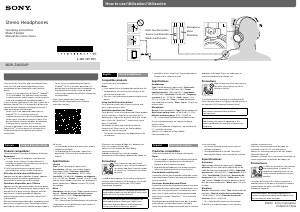
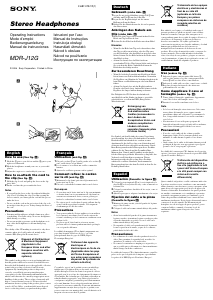
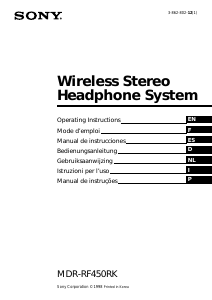
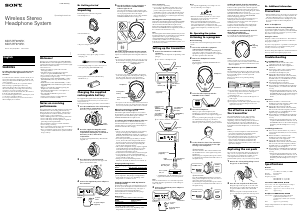
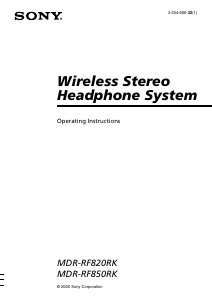
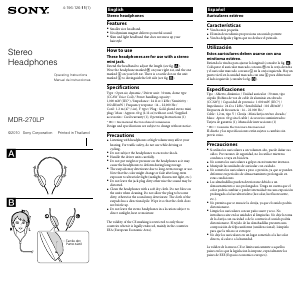
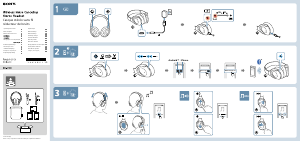
Praat mee over dit product
Laat hier weten wat jij vindt van de Sony MDR-RF912RK Koptelefoon. Als je een vraag hebt, lees dan eerst zorgvuldig de handleiding door. Een handleiding aanvragen kan via ons contactformulier.